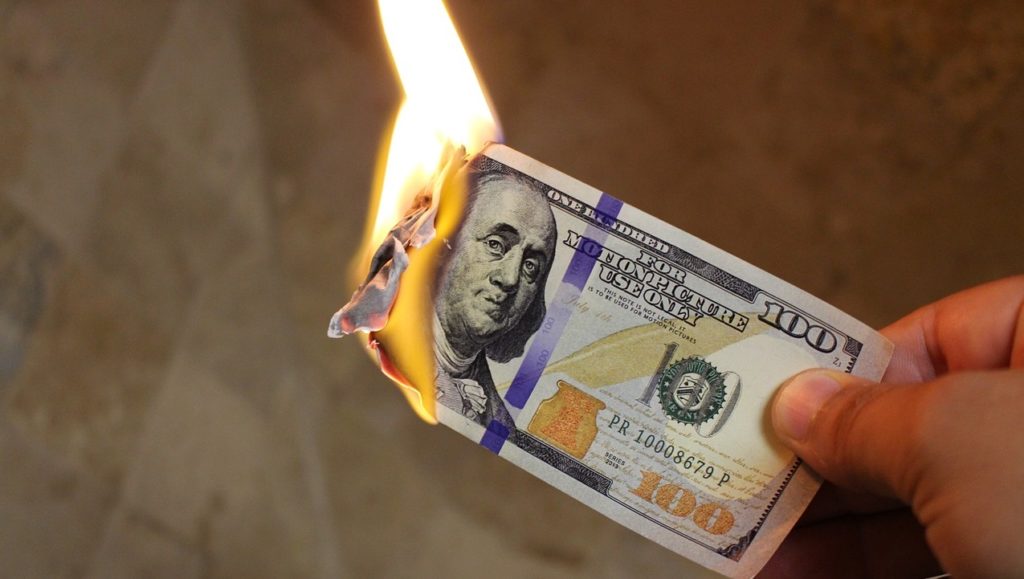Spending Us Into Oblivion: Federal Budget Deficit Tops $1 Trillion in 2019 Calendar Year
The US federal government ran a budget deficit of over $1 trillion in the 2019 calendar year. It was the first budget deficit over $1 trillion in any calendar year since 2012 — in the midst of the Great Recession.
The budget shortfall from January through December totaled $1.02 trillion, according to the latest report issued by the Treasury Department. That continued a rapidly accelerating upward trajectory. The 2019 budget gap was 17.1% bigger than the 2018 deficit, which was a 28.2% increase over 2017.
The budget deficit for fiscal 2019 (October 2018-September 2019) came in just under $1 trillion at $984 billion. That represented 4.7% of GDP, the highest percentage since 2012. It was the fourth consecutive year in which the deficit increased as a percentage of GDP. The debt-to-GDP ratio is estimated to have increased a hefty 26% over last year.
The CBO estimates the budget deficit for fiscal 2020 will eclipse $1 trillion.
These are the kind of budget deficits one would expect to see during a major economic downturn. The federal government has only run deficits over $1 trillion in four fiscal years, all during the Great Recession. We’re approaching that number today, despite having what Trump keeps calling “the greatest economy in the history of America.”
Generally, during economic expansions, government spending on social programs shrinks and tax revenues climb with increased economic activity. Revenues have increased over the last year, even with the Republican tax cuts, but they haven’t kept pace with the increase in government spending.
The spending didn’t slow in the first quarter of fiscal 2020. Through the first three months of the current fiscal year, the deficit ballooned to $356.6 billion. That’s an 11.8% increase from a year ago and puts the deficit on track to eclipse $1 trillion in this fiscal year.
In just three months, Uncle Sam blew through $1.16 trillion. Spending through the first three months of FY2020 is up 6.5% over the spending through the first three months of fiscal 2019.
Meanwhile, the national debt has climbed to $23.2 trillion.
To put that into perspective, last February, the national debt topped $22 trillion. When President Trump took office in January 2017, the debt was at $19.95 trillion. That represented a $2.06 trillion increase in the debt in just over two years. The borrowing pace continues to accelerate. The Treasury borrowed $800 billion through just two months late last summer. (If you’re wondering how the debt can grow by a larger number than the annual deficit, economist Mark Brandly explains here.)
The big deficit and debt numbers make for splashy headlines, but the mainstream mostly ignores the ramifications. Politicians make vague promises about cutting spending at some undetermined time in the future and policymakers offer enthusiastic assurances that economic growth will fix the budget problems. But in truth, government debt and spending retard economic growth. Europe’s spending binge serves as a prime example.
The reality is America’s fiscal condition is circling the drain.
During the presidential campaign, Trump promised to deal with the skyrocketing national debt. In fact, he said he could take care of it “fairly quickly.” But the president hasn’t even played lip-service to reining in spending, instead, calling for more outlays for the military and championing paid parental leave for government employees.
Of course, Congress also bears a great deal of responsibility for Uncle Sam’s fiscal malfeasance. And spending money the Treasury doesn’t have is a bipartisan game. The Democrats are unapologetic big spenders, and while the GOP talks a good game, the sucks money from the public trough at an equally fast rate.
The bottom line is that the spending trajectory is unsustainable. If the US government is running $1 trillion deficits now, what will the country’s financial situation look like when the next recession hits? Congress and the president can continue to kick the can down the road, but they are about to run out of pavement.





 Since Nayib Bukele became president of El Salvador, El Salvador has been in American media and global political discussion more than ever. While much of the attention focuses on Bukele’s mass incarceration of gang members and a decline in homicide of over 70%, Bukele has also drawn attention to his favoritism towards Bitcoin and how he […]
Since Nayib Bukele became president of El Salvador, El Salvador has been in American media and global political discussion more than ever. While much of the attention focuses on Bukele’s mass incarceration of gang members and a decline in homicide of over 70%, Bukele has also drawn attention to his favoritism towards Bitcoin and how he […] With gold hitting yet another awe-inspiring all-time high in the wake of Powell’s remarks reassuring markets (more or less) to expect rate cuts in 2024, a few analysts are pointing out risk factors for a correction — so is there really still room to run?
With gold hitting yet another awe-inspiring all-time high in the wake of Powell’s remarks reassuring markets (more or less) to expect rate cuts in 2024, a few analysts are pointing out risk factors for a correction — so is there really still room to run? Gold hit a new all-time nominal high, surpassing the previous record set in December of the previous year. The precious metal’s price reached approximately $2,140, indicating a robust and continuing interest in gold as a safe-haven asset, despite a rather peculiar lack of fanfare from the media and retail investors. This latest peak in gold […]
Gold hit a new all-time nominal high, surpassing the previous record set in December of the previous year. The precious metal’s price reached approximately $2,140, indicating a robust and continuing interest in gold as a safe-haven asset, despite a rather peculiar lack of fanfare from the media and retail investors. This latest peak in gold […] The gold price has been surging, with unprecedented central bank demand gobbling up supply. It has been a force to behold — especially as US monetary policy has been relatively tight since 2022, and 10-year Treasury yields have rocketed up, which generally puts firm downward pressure on gold against USD.
The gold price has been surging, with unprecedented central bank demand gobbling up supply. It has been a force to behold — especially as US monetary policy has been relatively tight since 2022, and 10-year Treasury yields have rocketed up, which generally puts firm downward pressure on gold against USD.  Total gold demand hit an all-time high in 2023, according to a recent report released by the World Gold Council. Last week, the World Gold Council (WGC) released its Gold Demand Trends report, which tracks developments in the demand for and use of gold around the world. Excluding over-the-counter (OTC) trade, 2023 gold demand fell slightly from 2022 […]
Total gold demand hit an all-time high in 2023, according to a recent report released by the World Gold Council. Last week, the World Gold Council (WGC) released its Gold Demand Trends report, which tracks developments in the demand for and use of gold around the world. Excluding over-the-counter (OTC) trade, 2023 gold demand fell slightly from 2022 […]